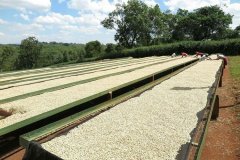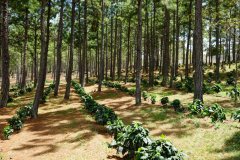Where is Ethiopia's Guixia Village? Guixia Village Manor Coffee Flavor Features
Professional barista communication, please pay attention to coffee workshop (Weixin Official Accounts cafe_style)
Name: Gesha Village Geisha #912
Country: Ethiopia
Production area: Gesha
Category: Grade 2
Treatment: Natural Process
Breed: Wild Geisha
Altitude: 1900 - 2100 m
Flavor: White flower, bergamot, cantaloupe, green tea
Gesha Village's journey began in 2007 when Adam Overton and Rachel Samuel helped the Ethiopian government make a documentary about Ethiopian coffee. During the shoot, they first met Dr. Girma and visited the Gera Coffee Forest near Jimma. Dr. Girma is a coffee researcher with extensive information on coffee farming and farm management. In the course of their documentary, Rachel rediscovers the country of her birth and Adam becomes fascinated by the rich history of coffee's birthplace.

At the end of their coffee trip, they are eager to open their own coffee farm. They see too much untapped potential and opportunity in Ethiopia's wild coffee forests. Even though the country's coffee trade has been growing for a long time, Ethiopia's coffee industry lags far behind new coffee producers in terms of agriculture, innovative processing and terroir differences. This is the main difference between commercial coffee and specialty coffee today. Adam and Rachael targeted the boutique coffee market and established Gesha Village Coffee Estate.

From 2007 to 2010, they searched for their ideal place. One of the most important conditions is transportation, and the farm must be close to the capital (Addis Ababa). There are several other aspects to consider:
Altitude: Altitude ranges from 1800 to 2100 meters.
Relatively large areas of land (over 100 hectares).
Old/native trees.
There are shade trees.
There are roads.
There's a pipeline to the port.
No population was displaced.

As they visited numerous places, they found themselves drifting away from the capital. Finally, they found Gesha Town, very close to Ethiopia's border with Sudan. In this part of western Ethiopia, they found wild coffee growing in unexplored forests. It was a coffee paradise, and after meeting some of the local aborigines, they decided to develop at this location. In the fall of 2011, they signed the 471-hectare Gesha Village Estate. Soon, they hired a farm manager, Akalu. The Gesha Village (GV) team began their forest exploration, where they collected wild seeds from the nearby Gori Gesha forest.

After a year, the seeds were planted on 30 hectares of land. At the same time, the team began to get to know the local neighborhood residents who lived nearby. The first thirty hectares were small areas where GV teams were first tested. In the spring of 2012, the first kilo sample of the harvest was given to Adam and Rachel's friend Willem Boot before he had even been cup-tested. Willam is organizing a cup test in Ethiopia, and all the participants are amazed by the cup of coffee. So the GV team knows they are doing something special and meaningful.

To learn more about the land, the GV team decided to visit their neighboring coffee farms to try to learn more about the coffee varieties in the vicinity and try to harvest seeds from nearby forests. The team gradually learned that growing any variety was risky, adding Akalu and Dr. Girma's advice. The team decided to plant an Ethiopian Heirloom, largely released by the Jimma Agricultural Research Center (JARC). These are many of the varieties collected from the JARC expedition. During the cup test, the GV team felt that the coffee produced by Gesha Vilaage was the most amazing. Since species play such an important role in flavor, it makes sense for the GV team to seek out research partners to study the genetics of Gesha forest species, part of which seems to point to a link between Panamanian geisha and Gori Gesha forests.
Important Notice :
前街咖啡 FrontStreet Coffee has moved to new addredd:
FrontStreet Coffee Address: 315,Donghua East Road,GuangZhou
Tel:020 38364473
- Prev

Introduction to the flavor characteristics of coffee beans at the southernmost tip of Yejasuefei and Kenyan coffee
For the exchange of professional baristas, please follow the coffee workshop (Wechat official account cafe_style). The Tore Village village of Yejashafi is located in Borena Zone, the southernmost tip of Oromia State in southern Ethiopia, with the southern end adjacent to Kenya. The village's Thor Wet treatment Plant (Tore Wet Mill) began in 2009 AD.
- Next

Flavor characteristics of coffee beans in Kaiyong Mountain, a small town in Shaqisuo, Guji, Ethiopia.
For the exchange of professional baristas, please follow the coffee workshop (Wechat official account cafe_style) Kaiyong Mountain Coffee Farm is located in the town of Tarro in Shakiso County, Shakiso County, Guji Zone District, Southern Ethiopia. The farm is located on Kaiyong Mountain with an altitude of about 1900-2050 meters and a total area of 200 hectares.
Related
- Detailed explanation of Jadeite planting Land in Panamanian Jadeite Manor introduction to the grading system of Jadeite competitive bidding, Red bid, Green bid and Rose Summer
- Story of Coffee planting in Brenka region of Costa Rica Stonehenge Manor anaerobic heavy honey treatment of flavor mouth
- What's on the barrel of Blue Mountain Coffee beans?
- Can American coffee also pull flowers? How to use hot American style to pull out a good-looking pattern?
- Can you make a cold extract with coffee beans? What is the right proportion for cold-extracted coffee formula?
- Indonesian PWN Gold Mandrine Coffee Origin Features Flavor How to Chong? Mandolin coffee is American.
- A brief introduction to the flavor characteristics of Brazilian yellow bourbon coffee beans
- What is the effect of different water quality on the flavor of cold-extracted coffee? What kind of water is best for brewing coffee?
- Why do you think of Rose Summer whenever you mention Panamanian coffee?
- Introduction to the characteristics of authentic blue mountain coffee bean producing areas? What is the CIB Coffee Authority in Jamaica?

